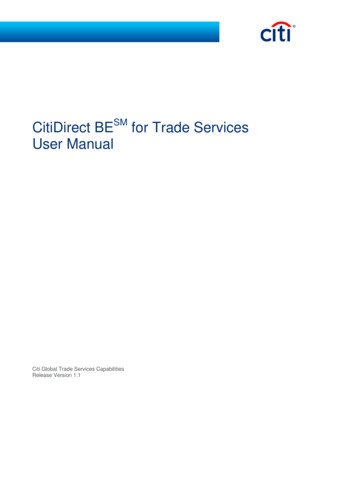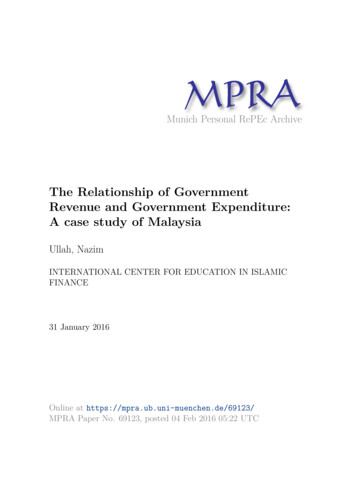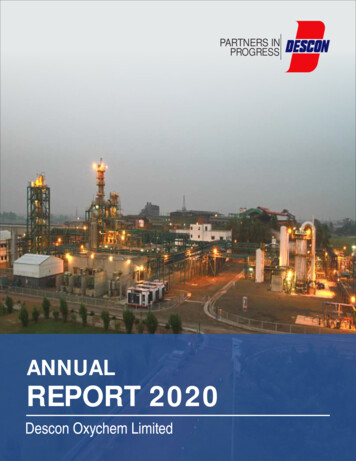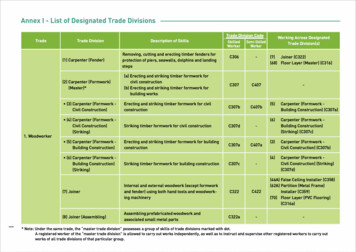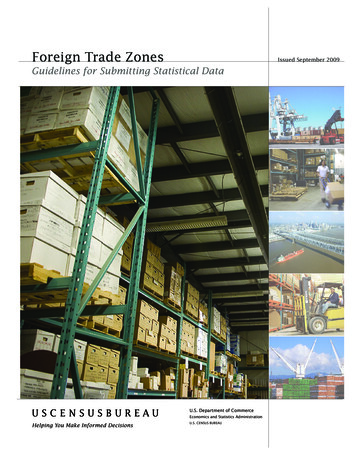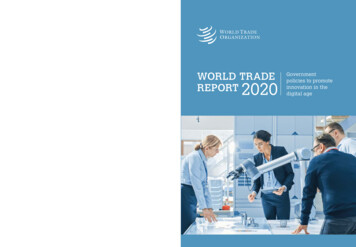
Transcription
World Trade Report 2020A defining feature of government policies adopted in recent yearshas been their support of the transition towards a digital economy.Trade and trade policies have historically been important engines forinnovation. In particular, the multilateral trading system has contributedsignificantly to the global diffusion of innovation and technology byfostering predictable global market conditions and by underpinning thedevelopment of global value chains. As data become an essential inputin the digital economy, firms rely more on intangible assets than onphysical ones, and digital firms are able to reach global markets fasterwithout the amount of physical investment previously necessary inother sectors. Success in the digital economy will depend on openness,access to information and communication technology (ICT) goodsand services, collaboration on research projects, and the diffusion ofknowledge and new technology.The World Trade Report 2020 shows that there is a significant role forinternational cooperation to make the pursuit of digital developmentand technological innovation more effective, while minimizing negativespill-overs from national policies. The WTO agreements, reached aquarter of a century ago, have proved to be remarkably forwardlooking in providing a framework that has favoured the developmentof ICT-enabled economies across all levels of development. Furtherinternational cooperation at the WTO and elsewhere would enablecontinued innovation and reduce trade tensions to help internationalmarkets function more predictably.ISBN 978-92-870-5045-8World Trade Report 2020 Government policies to promote innovation in the digital ageIn the digital age, a growing number of governments have adoptedpolicies aimed at boosting growth through innovation and technologicalupgrading. The World Trade Report 2020 looks at these trends and athow trade and the WTO fit with them.WORLD TRADEREPORT2020Governmentpolicies to promoteinnovation in thedigital age
What is the WorldTrade Report?The World Trade Report is anannual publication that aims todeepen understanding abouttrends in trade, trade policyissues and the multilateraltrading system.What is the 2020Report about?The 2020 World Trade Reportlooks at the role of innovationand technology policies in anincreasingly digitalized worldeconomy, and explains the roleof the WTO in this changingcontext.Find out moreWebsite: www.wto.orgGeneral enquiries:enquiries@wto.orgTel: 41 (0)22 739 51 11World Trade Organization154, rue de LausanneCH-1211 Geneva 2SwitzerlandTel: 41 (0)22 739 51 11www.wto.orgWTO PublicationsEmail: publications@wto.orgWTO Online Bookshophttp://onlinebookshop.wto.orgReport designed by Triptik.Printed by the World Trade Organization.Image credits:Cover: Shutterstock/Gorodenkoff.Pages 14-15: Getty Images/Cravetiger.Pages 22-23: iStock/EvgeniyShkolenko.Pages 78-79: Getty Images/Monty Rakusen.Pages 128-129: iStock/sanjeri. World Trade Organization 2020Print ISBN 978-92-870-5044-1.Web ISBN 978-92-870-5045-8.Published by the World Trade Organization.
CONTENTSContentsAcknowledgements and Disclaimer2Abbreviations and symbols3Foreword by Deputy Directors-General Agah, Brauner, Wolff and Yi4Executive summary6A. Introduction141. A new wave of government policies162. Government policies redux163. Government policies are as old as industrialization174. Maximizing positive spill-overs while minimizing the negative ones –the critical role of international cooperationB. Defining innovation-oriented government policies and their evolution in the digital age19221. Introduction242. A new wave of government policies: when, where, what?243. Mapping government policy instruments in the digital era: old tools, new tools494. Conclusions75C. Innovation policy, trade and the digital challenge781. Introduction802. The rationale for innovation policy in the digital era833. The determinants of innovation in the digital era924. Cross-border effects of innovation policies1175. Conclusions123D. International cooperation on innovation policies in the digital age1281. Introduction1302. The existing framework of international cooperation1303. Do we need more cooperation on innovation policies in the digital age?1564. Conclusions171Opinion piecesJustin Yifu Lin, “Industrial policy revisited”26Mariana Mazzucato, “Mission-oriented innovation and industrial policy”101Emily J. Blanchard, “Education and health as industrial policy”111Dani Rodrik, “Industrial policy, innovation and global rules”162Bibliography176Technical notes193List of figures, tables and boxes198WTO members201Previous World Trade Reports2021
WORLD TRADE REPORT 2020AcknowledgementsThe World Trade Report 2020 was prepared under thegeneral responsibility of Xiaozhun Yi, WTO DeputyDirector-General, and Robert Koopman, Directorof the Economic Research and Statistics Division.The report was coordinated by Marc Auboin andAnkai Xu. The authors of the report are Marc Auboin,Marc Bacchetta, Cosimo Beverelli, Eddy Bekkers,Kian Cassehgari Posada, Emmanuelle Ganne, JohnHancock, Kathryn Lundquist, Gabrielle Marceau,José-Antonio Monteiro, Roberta Piermartini, StelaRubínová, Victor Stolzenburg, Ankai Xu and Qing Ye(Economic Research and Statistics Division).Several divisions in the WTO Secretariat providedvaluable inputs and comments on drafts. Inparticular, written contributions were provided bycolleagues from the Agricultural and CommoditiesDivision (Rolando Alcala, Christiane Wolff), theDevelopment Division (Théo Mbise, MichaelRoberts), the Intellectual Property, GovernmentProcurement and Competition Division (RogerKampf, Wolf Meier-Ewert, Anna Caroline Müllerand Antony Taubman), the Legal Affairs Division(Jenya Grigorova), the Market Access Division(Helen Chang, Mark Henderson, Dolores Halloran,Darlan Marti, Roy Santana and Xiaobing Tang), theRules Division (Quentin Baird, Seref Coskun), theTrade and Environment Division (Lauro Locks, DevinMcDaniels), the Trade in Services and InvestmentDivision (Antonia Carzaniga, Juan Marchetti and LeeTuthill) and the Trade Policy Review Division (AntoniaDiakantoni, Peter Pedersen). Trineesh Biswas fromthe Office of the Director-General provided valuableadvice and guidance.External contributions were received from EmilyBlanchard (Dartmouth College), Justin Yifu Lin(Peking University), Mariana Mazzucato (UniversityCollege London), and Dani Rodrik (HarvardUniversity). The following individuals from outside theWTO Secretariat also provided useful comments onearly drafts of the report: Amrit Abahri, Reda Cherif,Dan Ciuriak, Simon Evenett, Caroline Freund, AnabelGonzález, Fuad Hasanov, Beata Javorcik, Eun-Ju Kim,Tabitha Kiriti, Zonglai Kou, Nathan Lane, Mia Mikic,Julia Nielson, Delei Peng, Boopen Seetanah, WilmaViviers, Sacha Wunsch-Vincent and Lei Zhang.Research assistance was provided by Razi Iqbal,Hemanth Kalathuru, Raghav Kapur, Maxime Ladrière,Shelley Moore, Daniil Orlov and Alvin Wang.Additional charts were provided by Florian Eberthand Simon Evenett.The text production of the Report was managedby Anne Lescure and Diana Dent of the EconomicResearch and Statistics Division. The productionof the Report was managed by Anthony Martin andHelen Swain of the Information and External RelationsDivision. Helen Swain edited the report. Gratitudeis also due to the translators in the Language andDocumentation Services Division for the high qualityof their work.DisclaimerThe World Trade Report and its contents are the sole responsibility of the WTO Secretariat, except forthe opinion pieces, which are the sole responsibility of their authors. The Report does not reflect theopinions or views of members of the WTO. The authors of the Report also wish to exonerate those whohave commented upon it from responsibility for any outstanding errors or omissions.2
ABBREVIATIONS AND SYMBOLSAbbreviations and symbolsADantidumpingMERCOSUR Southern Common MarketAIartificial intelligenceMFNmost-favoured nationAPECAsia-Pacific Economic CooperationMNCmultinational corporationASEANAssociation of Southeast Asian NationsBEPSbase erosion and profit-shiftingMSME micro, small and medium-sizedenterpriseCARICOMCaribbean CommunityCPTPP Comprehensive and ProgressiveAgreement for Trans-Pacific PartnershipCVDcountervailing dutiesEAEUEurasian Economic UnionECIPE European Centre for InternationalPolitical EconomyOECD Organisation for EconomicCo-operation and DevelopmentPPEpersonal protective equipmentR&Dresearch and developmentRTAregional trade agreementSCMsubsidies and countervailing measuresSEZspecial economic zoneEEAEuropean Economic AreaSMEsmall and medium-sized enterpriseFDIforeign direct investmentSOEstate-owned enterpriseFTAfree trade agreementGATSGeneral Agreement on Trade in ServicesSTEM science, technology, engineeringand mathematicsGATTGeneral Agreement on Tariffs and TradeGBARDgovernment budget allocations for R&DGDPgross domestic productGNPgross national productGPA WTO Government ProcurementAgreementGPTgeneral-purpose technologyTBTtechnical barriers to tradeTPRTrade Policy ReviewTRIMS Agreement on Trade-RelatedInvestment MeasuresTRIPS Trade-Related Aspects of IntellectualProperty RightsUNCTAD United Nations Conferenceon Trade and DevelopmentICT information and communicationtechnologyUNECE United Nations EconomicCommission for EuropeIEC International ElectrotechnicalCommissionUNEPUnited Nations Environment ProgrammeIoTInternet of ThingsUNESCO United Nations Educational, Scientificand Cultural OrganizationIPintellectual propertyUNICEFIPAinvestment promotion agencyUNIDO United Nations IndustrialDevelopment OrganizationISO International Organization forStandardizationUnited Nations Children’s FundISPinternet service providerUSMCA United States-Mexico-CanadaAgreementITinformation technologyWHOWorld Health OrganizationITAWTO Information Technology AgreementWTOWorld Trade OrganizationITCInternational Trade CentreITUInternational Telecommunication UnionLDCleast developed countryLLUlocal loop unbundling3
WORLD TRADE REPORT 2020Foreword by DeputyDirectors-GeneralAgah, Brauner,Wolff and YiIn the digital age, a growing number of governmentshave adopted policies aimed at boosting growththrough innovation and technological upgrading. Thedomestic economic fallout linked to the COVID-19pandemic is leading countries to strengthen thesepolicies. This report looks at these trends, and athow trade and the WTO fit in. It shows that there is asignificant role for international cooperation to makecountries’ pursuit of such goals more effective, whileminimizing negative spill-overs from national policies.Historically, governments have sought to use policyto enhance long-term economic growth or societalwelfare. These policies have always had to balancemultiple objectives, from attempts to correct realor perceived market failures, to the dual task ofmanaging change in mature sectors, while promotingemerging industries and technologies. Over thepast two decades, countries have targeted theseobjectiveswith increasinglyoutward-orientedpolicies, in recognition that openness by access tolarger markets and increased competition leads firmsto innovate. Trade and trade policy have historicallybeen important engines for innovation. The certaintyand predictability in global market conditions fosteredby the multilateral trading system has made a majorcontribution to innovation and technology diffusionglobally, notably by underpinning the rise of globalvalue chains. Countries have accessed advancedtechnology by importing capital goods, technologiesand building knowledge through partnerships andglobal value chain participation. The economicliterature and experience in many countries highlightthat innovation, productivity and other key objectivesof government policies are best served by broadlyopen global markets.4Today, a defining feature of government policies is tosupport the transition towards the digital economy.This transition has become the key objective ofso-called “new industrial policies”, whose conceptualbasis and content have been partly reshaped bythe distinct features of the digital economy. As databecomes an essential input, firms rely more onintangible assets than on physical ones. Digital firmsare more scalable, reach global markets faster, andlarge players may expand globally without the amountof physical investment previously necessary in othersectors. Success in the digital economy underscoresthe need for openness, for access to informationand communications technology (ICT) goods andservices, open-source technology, foreign markets,collaborative research projects, and in general for thediffusion of knowledge and new technology.Spurring innovation in the digital field, whether“new in the world” or “new in the country”, is at thecore of many new industrial policies adopted incountries at all levels of development in recent years.Governments typically justify these interventions onthe grounds of market failures in financing innovationand entrepreneurship, the existence of economywide spill-overs for general-purpose technologies,the public nature of knowledge, and the presence ofnetwork externalities. The Report finds that some ofthe policy instruments being employed are relativelynew (data policies, some collaborative research anddevelopment support, knowledge diffusion throughagglomeration, technological hubs) while othersare more conventional (tariffs for infrastructuralequipment, investment and tax incentives, innovationbased procurement and intellectual property policies).The Report observes that many developing countrieshave adopted proactive policy frameworks to promotedigital development and technological innovation,with a view, inter alia, to catching up on infrastructure,developing the digitization of production and buildingdomestic capacity for a software/app economy whichrelies on open-source technologies. Innovation inthe digital field is widely sought by countries at alldevelopment levels. Provided they continue to catchup on internet infrastructure and the right policy andbusiness environment, least-developed countriesstand to gain increasingly in digital service exports,participation in global value chains, and the economicinclusion fostered by affordable mobile services.The Report notes that government policies retain“defensive” aspects, particularly in mature nondigital sectors subject to intense competition andtechnological transition. The greatest concentration
FOREWORD BY DEPUTY DIRECTORS-GENERAL AGAH, BRAUNER, WOLFF AND YIof “protective” policy instruments is seen in thesesectors, aiming to manage the transition and addressemployment concerns.In the digital field, the WTO and its existing rulebookalready support innovation directly and indirectly inmany ways: directly, by eliminating tariffs on internet andtelecommunications infrastructure products through theInformation Technology Agreement (ITA) and extendingthese benefits to non-ITA members, by liberalizinginternet services through the telecommunicationsagreement, and by stimulating e-commerce with themoratorium on duties on cross-border digital flows,as well as by providing a robust and stable frameworkfor the development of global and open standards,intellectual property protection and other criticalrules based on the principles of non-discrimination,transparency and reciprocity; and indirectly, through theimproved resource allocation and efficiency that comewith open trade, which frees up resources that can bedevoted to new cutting-edge pursuits.The WTO agreements reached a quarter-century agoproved to be remarkably forward-looking in providinga framework that helped foster the developmentof an ICT-enabled economy in countries across alllevels of development, while preserving policy spacefor countries to pursue different models of digitaldevelopment.Yonov Frederick AgahDeputy Director-GeneralKarl BraunerDeputy Director-GeneralJust as it has fostered broadly open, predictable andcompetitive markets in the wider global economy,the WTO can in the years ahead play an importantrole in reducing uncertainty in markets for digitalgoods and services. But this will mean updating theWTO framework to address new challenges anddemands. For example, the rising importance of dataleads to growing demands for shared internationalunderstanding on data transfer, localization andprivacy. International cooperation would be useful tofoster innovation and interoperability and to reducetensions in ways that would make internationalmarkets function more predictably.This report looks at how international cooperation –at the WTO, on Aid for Trade and elsewhere – canaddress these challenges and maximize the positivespill-overs from governments’ policies to promoteinnovation. While, in many instances, digital marketsenhance competition and generate positive spillovers for the rest of the economy, the Report alsowarns that the winner-takes-all characteristicsof certain digital industries could lead to policyresponses that raise tensions between countries andintroduce unnecessarily high market barriers. Here,international cooperation could play a particularlyvaluable role in limiting negative spill-overs.Alan WolffDeputy Director-GeneralXiaozhun YiDeputy Director-General5
WORLD TRADE REPORT 2020Executive summaryA. IntroductionIn the digital age, a growing number of governmentshave adopted policies aimed at boosting growththrough innovation and technological upgrading. Thedomestic economic fallout linked to the COVID-19pandemic is leading countries to strengthen thesepolicies. This report looks at those trends, and athow trade and the WTO fit into them. It shows thatinternational cooperation could play a significantrole in making countries’ pursuit of such goals moreeffective, while minimizing the negative spill-oversfrom national policies.The shift towards digitalization and knowledge-basedeconomies highlights the increasing importance ofinnovation and technology to economic growth. Underthe so-called “new industrial policies”, governmentpolicies aim at shifting domestic production towardsnew, enabling digital technologies, while at thesame time facilitating the modernization of matureindustries.At each phase of policymaking, governments have tobalance multiple objectives, from attempts to correctreal or perceived market failures, to the dual task ofmanaging change in mature sectors, while promotingemerging industries and technologies. Over the pasttwo decades, economies have met these objectiveswith increasingly outward-oriented policies, inrecognition of the fact that openness – access tolarger markets and increased competition – leadsfirms to innovate.The digital age further underlines this need foropenness. Trade and trade policy have historicallybeen important engines for innovation. The certaintyand predictability in global market conditions fosteredby the multilateral trading system have made anenormous contribution to innovation and technologydiffusion globally, notably by underpinning the riseof global value chains. Countries have accessedadvanced technology by importing capital goods, bymeans of technologies, and by building knowledgethrough partnerships and global value chainparticipation.6Today, a defining feature of government policies is tosupport the transition towards the digital economy,which is one reason why more and more international cooperation is necessary if outwardoriented policies are to be effective. In the context of“new industrial policies” and related policies gearedtowards innovation, and the transition towards thedigital economy, some of these strategies can havepositive spill-overs for other countries – generatinggrowth, creating new markets and encouragingtechnology diffusion. At other times, these strategiescan have negative spill-overs – distorting trade,diverting investment, or promoting unfair competition.The challenge for WTO members is to provide aframework of shared rules that encourages positivesum outcomes and discourages zero- or negative-sumones. This is not a new challenge. The system that wascreated after the Second World War was designedprecisely to reconcile international rules with nationalpolicy space and flexibility.B. Defining innovation-orientedgovernment policies and theirevolution in the digital ageIn many countries, government policies attemptto improve the business environment or to tilt thestructure of economic activity toward sectors,technologies or tasks that are expected to offer betterprospects for economic growth or societal welfarethan would occur in the absence of such intervention.Governments are generally motivated to implementpolicies at the sectoral level in order to boost longterm growth, increase incomes and productivity,and, in doing so, promote entrepreneurship,innovation, technology transfer, skill developmentand competition as specific policies to achieve theseobjectives.Over time, there have been several phases ofgovernment policies, with considerable varianceacross economies. In the early days, industrialpolicies were narrowly defined as policies thataimed to build capacity mainly in the manufacturingsector. The 1980s marked a gradual shift away frompolicies based on import substitution, infant industryprotection and direct intervention into the productionprocess, towards more outward-oriented policies.Some countries anticipated that shift even earlier.In the 1990s, industrial policies further embracedopen economy requirements: skills upgrading,acquisition of technological capacity, reductionof business and trade costs, and infrastructuredevelopment, for example, as important mediumterm objectives. Industrial and trade policies aimed
EXECUTIVE SUMMARYto improve the international competitiveness offirms and their integration into global value chains.Governments also introduced strong horizontal, orcross-sectoral, objectives aimed at providing theinfrastructure for economic growth, although thehorizontal focus did not completely displace sectoralpolicies, which remained a prominent feature ofindustrial policies.By the turn of the millennium, the notion of industrialpolicy had shifted significantly, with the conceptof “industrial” extending beyond the manufacturingsector and evolving towards a model of greaterstrategic collaboration between the private sectorand governments, characterized by the relativelylarge presence of public-private partnerships andprogrammes to boost research and development(R&D).Since the 2008-09 financial crisis, there has been anundeniable resurgence of government policies aimedat fostering change in the allocation of resources byeconomies, as reflected in the number of economiesin which such policies have been developed and inthe ambition of policy plans. “New industrial policies”,“Industrial 4.0”, “digital transition plans” havebeen designed in a context of profound industrialreorganization and parallel to the emergence ofground-breaking digital technologies and advancedmanufacturing supply chains. For many countries,the principal aim is to modernize their economies,including their traditional manufacturing sectors, ina way that promotes the shift from mechanical andanalogic production to digitally enabled productionprocesses and services.Hence a key and defining feature of “new industrialpolicies” is their prime focus on innovation,technological development and upgrading in thedigital field.Innovation can be understood as the transformationof an invention into marketable products andservices, new business processes and organizationalmethods, as well as the absorption, adaptation anddissemination of novel technologies and know-how.Innovation-oriented government policies are thereforepublic interventions to support the generation anddiffusion of innovation.In practice, technological upgrading and thedigitalization of production processes and servicesare embodied in the economic development planof many countries, while in others, a specificdigital development plan and an innovation plancomplements an industrial strategy. Many developingcountries have adopted proactive policy frameworksto promote digital development and technologicalinnovation with a view, for example, to catching upon digital and telecommunications infrastructure,developing the digitalization of production andbuilding capacity for a software/app economy reliant,in the main, on open-source technologies.Providing an overview of industrial and innovationpolicies in the digital space, this report examineshow policy instruments evolve, distinguishing what istruly new from what simply adapts policy instrumentsalready at use in “traditional sectors”. Certainpolicy tools and instruments are clearly integral tothe digital economy: data policies, R&D supportapplied to digital technologies, skill and knowledgediffusion; other policy instruments such as investmentincentives and intellectual property rights regimes aremore “conventional” and need to adapt when appliedto the digital sector.“New industrial policies” can also display “defensive”aspects, particularly in non-digital sectors, whichare the most mature, and which may be subject tocompetition and technological transition. A snapshotof the use of government policy tools, based onpublic sources including the WTO Trade MonitoringDatabase, complemented by the Centre for EconomicPolicy Research (CEPR)’s Global Trade Alertdatabase, shows the relatively active use of industrialand trade policy instruments of a “defensive” naturein traditional sectors such as minerals, metals andchemical industries, and to a lesser extent in textilesand clothing, electrical machinery, and transportequipment. This is notably the case for new bordermeasures including import tariffs, export dutiesand non-tariff measures, which account for onethird of the policy measures implemented since the2008-09 financial crisis. The analysis of domesticsupport measures is less clear, as many of thedomestic support measures are horizontal in nature.Where they are identifiable, sector-specific supportmeasures tend to focus on sectors such as transportequipment, minerals and metals.Investment policies, which are still at the heart ofindustrial strategies, are characterized by a trend tooffer incentives and attract foreign direct investment(FDI), notably in increasingly popular special economiczones (i.e. areas in a country in which the businessand trade laws differ from those of the rest of thecountry). Fiscal and financial incentives, such as taxor tariff exemptions and subsidized services, are themost prevalent investment promotion tools amongeconomies of all development levels. Meanwhile, FDIpolicies adapt to the characteristics of the digitaleconomy, in which firms no longer need to serve foreignmarkets by building large manufacturing capacity and7
WORLD TRADE REPORT 2020hence firms’ criteria to invest abroad emphasize skillsand the quality of digital infrastructure.The novelty of government policies in the digital age isperhaps in the requirement for a better articulation ofthe various policies supporting the establishment of anew digital supply chain. While ambitions to innovatein digital technologies may vary from one economy toanother, many countries – including least-developedcountries – do have explicit digital strategies tomake the most of the digital technologies, with aview to producing software, providing e-servicesand/or participating in e-commerce. The concept ofinnovation in some developing countries may differsomewhat from that of the few frontier countries in thisfield, as in these cases innovation indicates adoptingexisting technologies rather than inventing new ones.For these countries, their objectives include catchingup with more technologically advanced economiesand building alternative capacity for software/domestic “app” economies which can rely on opensource technologies.Several features of the digital economy underline theevolution of this new phase of industrial and innovationpolicies. As data become an essential input in everyaspect of economic activity, many digital technologieshave the potential to alter economies and redefineinnovation, and they are thereby considered to begeneral-purpose technologies. In particular, digitaltechnologies foster collaboration and help to forminnovative ecosystems. Firms in the digital economyrely less on physical assets and more on intangibleassets. This makes firms much more scalable (i.e.capable of expanding), allowing them to reach globalmarkets, and some market players have come to holddominant positions in the digital sector.8As a result of these special features, governmentpolicies have been evolving in such a way as toencourage innovation in the digital space. Openand transparent data policies are an integralpart of innovation policy, as actors need a clearframework for data use, transfer and protection.Government support in building and upgradingtelecommunications infrastructure serves as anenabling condition to scale up digital services.Government policies also aim to foster innovationby supporting the promotion of science, offeringspecific mission-oriented or broad R&D support,developing innovation hubs, promoting digital literacyand skills, and encouraging e-government servicesas well as innovation procurement. Policy design hasto be collaborative and adaptative to allow for thecoordination of many more policy fields and favourmore experimentation. Collaboration with the privatesector is also being sought more systematically.In the assessment of domestic policies surroundingdigital technologies and related activities, a carefulexamination has to be made. Many national policiesin the digital area, such as those which seek toimprove the digital infrastructure, offer R&D supportin general-purpose technologies, and develop digitalskills, tend to be horizontal in nature, and hence aredeemed, according to the economic literature, tobe a priori l
trading system. What is the 2020 Report about? The 2020 World Trade Report looks at the role of innovation and technology policies in an increasingly digitalized world economy, and explains the role of the WTO in this changing context. Find out more Website: www.wto.org General enquiries: en
